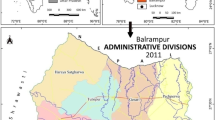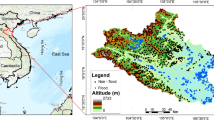Abstract
Flooding has become an exceedingly complex problem in many developing countries of the world including Bangladesh. Currently, Bangladesh is using MIKE 11 hydrodynamic model for flood forecasting. Previous studies indicated that hybridized machine learning models, especially support vector regression (SVR) models outperform standalone machine learning and other numerical models in mapping flood susceptibility. However, no study has been conducted on the flood dataset of Bangladesh using hybridized SVR model to predict flood susceptibility. In the present study, we have collected and modeled the recent flood inundation dataset of Bangladesh in terms of nine flood factors and explored their relative importance rank using the random forest (RF) algorithm. Then, we employed a genetic algorithm (GA) optimized SVR with radial basis function (RBF) kernel (hybridized GA-RBF-SVR) model along with the stand-alone RBF-SVR and multilayer perceptron (MLP) models to predict the flood susceptibility map for the whole country. The result of the hybridized SVR model is very promising to be employed in decision making to deal with the flood forecasting problem in Bangladesh.
Access this chapter
Tax calculation will be finalised at checkout
Purchases are for personal use only
Similar content being viewed by others
References
Rahman, A., Alam, M., Alam, S., et al.: Risks vulnerability and adaptation in Bangladesh Human Development Repositor (2007)
Rahman,R., Salehin, M.: Flood risks and reduction approaches in Bangladesh. In: Disaster Risk Reduction Approaches in Bangladesh, Tokyo, Springer (2013)
Leon, M., Barua, P., Sarker, P., et al.: Annual Flood Report 2019. IOP Publishing FFWC (2020). http://www.ffwc.gov.bd/images/annual19.pdf
Rahmati, O., Darabi, H., Panahi, M.: Development of novel hybridized models for urban flood susceptibility mapping. Sci. Rep. 10(1), 1–19 (2020)
Rahman, M., et al.: Flood susceptibility assessment in Bangladesh using machine learning and multi-criteria decision analysis. Earth Syst. Environ. 3(3), 585–601 (2019). https://doi.org/10.1007/s41748-019-00123-y
Talukdar, S., Ghose, B., Pham, Q.: Flood susceptibility modeling in Teesta River basin, Bangladesh using novel ensembles of bagging algorithms. Stoch. Env. Res. Risk Assess. 34, 2277–2300 (2020)
Islam, T., Talukdar, S., Mahato, S.: Flood susceptibility modelling using advanced ensemble machine learning models. Geosci. Front. 12(3), 101075 (2020)
Jahangir, M., Reineh, S., Abolghasemi, M.: Spatial predication of flood zonation mapping in Kan River Basin, Iran, using artificial neural network algorithm. Weather Clim. Extremes 25 (2019)
Wang, Y., Fang, Z., Hong, H., Peng, L.: Flood susceptibility mapping using convolutional neural network frameworks. J. Hydrol. 582 (2020)
Islam, M., Sado, K.: Development of flood hazard maps of Bangladesh using NOAA- AVHRR images with GIS. Hydrol. Sci. J. 45, 337–355 (2000)
Adnan, MSG., Talchabhadel, R., Nakagawa, H., Hall, W.: The potential of tidal river management for flood alleviation in south western Bangladesh. Sci. Total Environ. 731 (2020)
Bui, D., Hoang, N., Costache, R.: A novel deep learning neural network approach for predicting flash flood susceptibility: a case study at a high frequency tropical storm area. Sci. Total Environ. 701, 134413 (2019)
Dt, B., Td, P., Jafaari, A.: A novel hybrid approach based on a swarm intelligence optimized extreme learning machine for flash flood susceptibility mapping. CATENA 179, 184–196 (2019)
Coulthard, T., Frostick, L.: The Hull floods of 2007: implications for the governance and management of urban drainage systems. J. Flood Risk Manag 3, 223–231 (2010)
Kassogué, H., Bernoussi, A., Maâtouk, M.: Two scale cellular automaton for flow dynamics modeling (2CAFDYM). Appl. Math. Model. 43, 61–77 (2017)
Map detail United Nations Institute for Training and Research. https://www.unitar.org/maps/map/3073
Vafakhah, M., Pourghasemi, H., Katebikord, A., Loor, S.: Comparing performance of random forest and adaptive neuro-fuzzy inference system data mining models for flood susceptibility mapping. Arabian. J. Geosci 13, 1–6 (2020)
Quang-Thanh, B., Quoc-Huy, N.: Verification of novel integrations of swarm intelligence algorithms into deep learning neural network for flood susceptibility mapping. J. Hydrol. 581, 124379 (2019)
Prajakta, P., Shaw, K., Malathi, P.: Speaker dependent speech emotion recognition using MFCC and Support Vector Machine. In: 2016 International Conference on Automatic Control and Dynamic Optimization Techniques (ICACDOT), Pune (2016)
Bangladesh Subnational Administrative Boundaries. https://data.humdata.org/dataset/administrative-boundaries-of-bangladesh-as-of-2015
Monsoon flood preliminary impact and KIN assessment. https://reliefweb.int/sites/reliefweb.int/files/resources/nawg_monsoon_flood_preliminary_impact_and_kin_20200725_final_draft.pdf
Response Plan Monsoon Floods (2020). https://www.humanitarianresponse.info/en/operations/bangladesh/document/hctt-monsoon-flood-humanitarian-response-plan-monitoring-dashboard-30
Dhaka tribune. https://www.dhakatribune.com/bangladesh/nation/2020/09/27/4th-time-flood-thakurgaon-records-worst-rain-in-a-decade
Acknowledgements
This work is supported by the ICT Innovation Fund (2020-21) provided by the ICT division, Ministry of Post, Telecommunication and Information Technology of the People’s Republic of Bangladesh.
Author information
Authors and Affiliations
Corresponding author
Editor information
Editors and Affiliations
Rights and permissions
Copyright information
© 2021 Springer Nature Switzerland AG
About this paper
Cite this paper
Siam, Z.S., Hasan, R.T., Anik, S.S., Noor, F., Adnan, M.S.G., Rahman, R.M. (2021). Study of Hybridized Support Vector Regression Based Flood Susceptibility Mapping for Bangladesh. In: Fujita, H., Selamat, A., Lin, J.CW., Ali, M. (eds) Advances and Trends in Artificial Intelligence. From Theory to Practice. IEA/AIE 2021. Lecture Notes in Computer Science(), vol 12799. Springer, Cham. https://doi.org/10.1007/978-3-030-79463-7_6
Download citation
DOI: https://doi.org/10.1007/978-3-030-79463-7_6
Published:
Publisher Name: Springer, Cham
Print ISBN: 978-3-030-79462-0
Online ISBN: 978-3-030-79463-7
eBook Packages: Computer ScienceComputer Science (R0)




